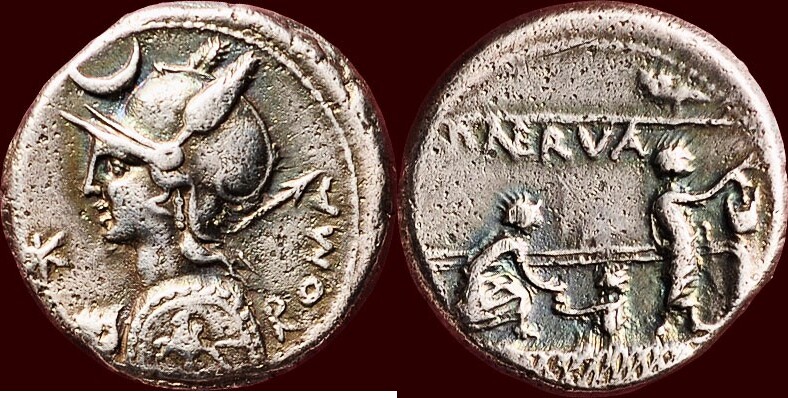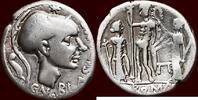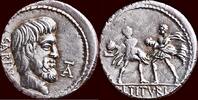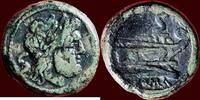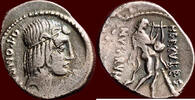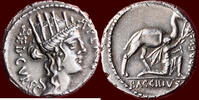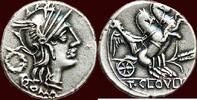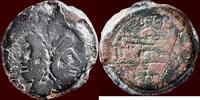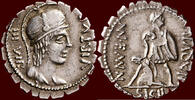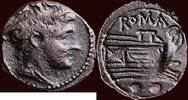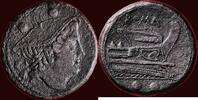MA-ID: 8055102010
Customer feedback Henzen
Schnelle Lieferung. Super Ware. Vielen Dank!
O.K.
perfekt !!!
Great coin, quick delivery, thanks!
AR Denarius (113-112 BC) ROMAN REPUBLIC - PUBLIUS LICINIUS NERVA - Rome cf. Künker auction 367, lot 7672 (in vf+ with mino
Munthandel G.Henzen 

10
On MA-Shops since 10 years
7244 ratings,
100 % Positive (last 24 months)
Worldwide shipping
736.91 £850,00 EUR
Import tax may be added
+ 22.54 £ shipping ( to United Kingdom )
Delivery time: 5 - 8 days
+ 22.54 £ shipping ( to United Kingdom )
| Customer Support +49 (0)2871 2180 383 |
| Payment methods |
| Wire Transfer |
weight 3,86gr. | silver Ø 16mm.
obv. Helmeted bust of Roma left, holding shield in left hand and spear over
shoulder in right in left field value XVI in monogram, crescent above, ROMA behind
rev. Voting scene: three citizens in the comitium one of them placing ballot
in cista. In middle field above, a tabella inscribed P and P•NERVA
One one of the most celebrated types of the Republican coinage this depicts the actual voting process in the political assembly of the Roman People in the Comitium, where citizens voted on business presented to them by magistrates. The area occupied by the Comitium was consecrated ground, like a temple, and was located in front of the Senate House in the Forum.
VOTING: By the late second century BC, there were two assemblies where adult Roman male citizens voted for candidates in elections and for proposed legislation, the Assembly of the Centuries and the Assembly of the Tribes (see Roman Government). Citizens voted in groups (centuries or tribes), entering a roped-off area and prceeding single file over raised gangways (pontes, ″bridges″). The voting procedure is depicted on the denarius offered here, issued by the moneyer P. Licinius Nerva in 113-112 BC. An attendant handed each voter a small wooden tablet covered with wax on which he inscribed his vote: V (for uti rogas, ″as you propose″ to support a bill), A (for antiquo, ″I vote against,″ to oppose a bill), or the candidate′s name in an election. He then dropped the tablet into a tall urn (cista). This was a time-consuming process requiring large spaces, so most voting was conducted in the Campus Martius. Julius Caesar began a large building for the electoral process in this area, the Saepta Julia, which was completed by Marcus Agrippa in 26 BC during the reign of Augustus. Publius Licinius Nerva was a Roman politician during the Late Roman Republic. In his early career he was triumvir monetalis. As a propraetor he was assigned as Governor of Sicily in 104 BC at the outbreak of the Second Servile War. In the midst of the Cimbrian War, Italian allies of Rome, upon the mustering of troops, protested publicani tax farmers selling their citizens into slavery as punishment for tax arrears. As these abuses interfered with Roman ability to speedily raise troops, the Senate decreed that any citizen of an ally would be immediately emancipated. The Senate assigned Nerva to establish a tribunal in Sicily to determine who qualified for release.
A coalition of slaveholders in Sicily confronted the praetor and, with bribes and threats, shut the tribunal down. Due to the mounting pressure from the slaveholders and the slaves themselves, Nerva feared violent outbreaks from the side who came off worse in the confrontation and refused to listen to any more of the slaves′ complaints. Claiming that they would not face repercussions for their actions, Nerva told the slaves to disperse and return to their masters. However, the slaves instead decided amongst themselves to start a revolt. Nerva tried to put down the revolt, but failed to react with decision by false promises he was able to return one body of the rebels to slavery, but neglected to address more serious outbreaks near Heraclea and near Lilybaeum. Eventually, Nerva dispatched a detachment of 600 soldiers to Heraclea but they were defeated, the slaves now gained confidence, having won a large supply of armaments. Nerva was replaced at the end of his term by Lucius Licinius Lucullus.
cf. Künker auction 367, lot 7672 (in vf+ with minor scratches: € 1.300 + 25%)
Sydenham 548 | Crawford 292/1 | Albert 1075 | Sear 169 R
attractive toning
vf
obv. Helmeted bust of Roma left, holding shield in left hand and spear over
shoulder in right in left field value XVI in monogram, crescent above, ROMA behind
rev. Voting scene: three citizens in the comitium one of them placing ballot
in cista. In middle field above, a tabella inscribed P and P•NERVA
One one of the most celebrated types of the Republican coinage this depicts the actual voting process in the political assembly of the Roman People in the Comitium, where citizens voted on business presented to them by magistrates. The area occupied by the Comitium was consecrated ground, like a temple, and was located in front of the Senate House in the Forum.
VOTING: By the late second century BC, there were two assemblies where adult Roman male citizens voted for candidates in elections and for proposed legislation, the Assembly of the Centuries and the Assembly of the Tribes (see Roman Government). Citizens voted in groups (centuries or tribes), entering a roped-off area and prceeding single file over raised gangways (pontes, ″bridges″). The voting procedure is depicted on the denarius offered here, issued by the moneyer P. Licinius Nerva in 113-112 BC. An attendant handed each voter a small wooden tablet covered with wax on which he inscribed his vote: V (for uti rogas, ″as you propose″ to support a bill), A (for antiquo, ″I vote against,″ to oppose a bill), or the candidate′s name in an election. He then dropped the tablet into a tall urn (cista). This was a time-consuming process requiring large spaces, so most voting was conducted in the Campus Martius. Julius Caesar began a large building for the electoral process in this area, the Saepta Julia, which was completed by Marcus Agrippa in 26 BC during the reign of Augustus. Publius Licinius Nerva was a Roman politician during the Late Roman Republic. In his early career he was triumvir monetalis. As a propraetor he was assigned as Governor of Sicily in 104 BC at the outbreak of the Second Servile War. In the midst of the Cimbrian War, Italian allies of Rome, upon the mustering of troops, protested publicani tax farmers selling their citizens into slavery as punishment for tax arrears. As these abuses interfered with Roman ability to speedily raise troops, the Senate decreed that any citizen of an ally would be immediately emancipated. The Senate assigned Nerva to establish a tribunal in Sicily to determine who qualified for release.
A coalition of slaveholders in Sicily confronted the praetor and, with bribes and threats, shut the tribunal down. Due to the mounting pressure from the slaveholders and the slaves themselves, Nerva feared violent outbreaks from the side who came off worse in the confrontation and refused to listen to any more of the slaves′ complaints. Claiming that they would not face repercussions for their actions, Nerva told the slaves to disperse and return to their masters. However, the slaves instead decided amongst themselves to start a revolt. Nerva tried to put down the revolt, but failed to react with decision by false promises he was able to return one body of the rebels to slavery, but neglected to address more serious outbreaks near Heraclea and near Lilybaeum. Eventually, Nerva dispatched a detachment of 600 soldiers to Heraclea but they were defeated, the slaves now gained confidence, having won a large supply of armaments. Nerva was replaced at the end of his term by Lucius Licinius Lucullus.
cf. Künker auction 367, lot 7672 (in vf+ with minor scratches: € 1.300 + 25%)
Sydenham 548 | Crawford 292/1 | Albert 1075 | Sear 169 R
attractive toning
vf
Please respect our order minimum of 20 Euros. For EU only IBAN payment please. Shippings to China are on risk of the buyer and only payment by bankwire or WISE. Shipping will take place within 5 days after receipt of payment. Sendings to Russia,Ukraine and Israel are not possible. Additional administration- and risk costs for PayPal & creditcard payments. No PayPal or creditcardpayments possible for orders over 10.000 euro.
| Shipping fees | ||||
|---|---|---|---|---|
| up to 86.70 £ | 86.70 £ to 433.48 £ | 433.48 £ to 866.95 £ | over 866.95 £ | |
| Argentina | 27.74 £ | 27.74 £ | 34.68 £ | 34.68 £ |
| Australia | 30.34 £ | 30.34 £ | 34.68 £ | 34.68 £ |
| Belgium | 8.24 £ | 9.54 £ | 11.27 £ | 15.61 £ |
| Brazil | 47.68 £ | 47.68 £ | 47.68 £ | 47.68 £ |
| Bulgaria | 12.14 £ | 13.87 £ | 30.34 £ | 39.01 £ |
| Chile | 43.35 £ | 43.35 £ | 43.35 £ | 43.35 £ |
| China | 34.68 £ | 34.68 £ | 43.35 £ | 43.35 £ |
| Denmark | 9.97 £ | 11.27 £ | 13.87 £ | 17.34 £ |
| Germany | 8.24 £ | 9.54 £ | 11.27 £ | 15.61 £ |
| Estonia | 11.27 £ | 12.14 £ | 13.00 £ | 21.67 £ |
| France | 8.24 £ | 9.54 £ | 13.87 £ | 21.67 £ |
| Greece | 13.00 £ | 21.67 £ | 26.01 £ | 30.34 £ |
| United Kingdom | 21.67 £ | 21.67 £ | 22.54 £ | 24.27 £ |
| Hong Kong | 34.68 £ | 34.68 £ | 43.35 £ | 43.35 £ |
| India | 30.34 £ | 30.34 £ | 34.68 £ | 43.35 £ |
| Indonesia | 30.34 £ | 30.34 £ | 34.68 £ | 34.68 £ |
| Israel | 173.39 £ | 173.39 £ | 173.39 £ | 173.39 £ |
| Japan | 34.68 £ | 34.68 £ | 34.68 £ | 34.68 £ |
| Cambodia | 56.35 £ | 56.35 £ | 56.35 £ | 56.35 £ |
| Canada | 26.01 £ | 26.01 £ | 30.34 £ | 30.34 £ |
| Liechtenstein | 17.34 £ | 17.34 £ | 21.67 £ | 21.67 £ |
| Luxembourg | 9.54 £ | 11.27 £ | 13.87 £ | 21.67 £ |
| Malaysia | 30.34 £ | 30.34 £ | 34.68 £ | 39.01 £ |
| Netherlands | 7.37 £ | 7.37 £ | 9.54 £ | 12.14 £ |
| Norway | 21.67 £ | 21.67 £ | 26.01 £ | 30.34 £ |
| Austria | 9.97 £ | 10.84 £ | 13.00 £ | 21.67 £ |
| Poland | 11.27 £ | 12.14 £ | 14.30 £ | 21.67 £ |
| Portugal | 11.27 £ | 12.14 £ | 15.61 £ | 21.67 £ |
| Romania | 13.87 £ | 15.61 £ | 21.67 £ | 30.34 £ |
| Russian Federation | 173.39 £ | 173.39 £ | 173.39 £ | 173.39 £ |
| Switzerland | 26.01 £ | 26.01 £ | 34.68 £ | 34.68 £ |
| Serbia | 21.67 £ | 21.67 £ | 26.01 £ | 30.34 £ |
| Singapore | 30.34 £ | 30.34 £ | 30.34 £ | 34.68 £ |
| Slovakia | 11.27 £ | 13.00 £ | 17.34 £ | 21.67 £ |
| Spain | 9.97 £ | 11.70 £ | 14.30 £ | 21.67 £ |
| Sri Lanka | 30.34 £ | 30.34 £ | 34.68 £ | 39.01 £ |
| Czech Republic | 10.40 £ | 12.14 £ | 15.61 £ | 21.67 £ |
| Ukraine | 173.39 £ | 173.39 £ | 173.39 £ | 173.39 £ |
| Hungary | 12.14 £ | 13.87 £ | 21.67 £ | 26.01 £ |
| United States | 27.74 £ | 27.74 £ | 30.34 £ | 34.68 £ |
| European Union | 13.00 £ | 14.74 £ | 21.67 £ | 26.01 £ |
| World | 34.68 £ | 34.68 £ | 43.35 £ | 43.35 £ |
Information
Online orders are welcome as always and will be shipped directly.
|
Seller Home | 0Shopping cart | Terms of sale | Contact | MA Terms of sale | Privacy policy | Warranty | MA-Shops New Items Copyright ® 2001-2025, MA-SHOPS Coins All Rights Reserved. Designated trademarks and brands are the property of their respective owners. |
 Buy coins with warranty
Buy coins with warranty



